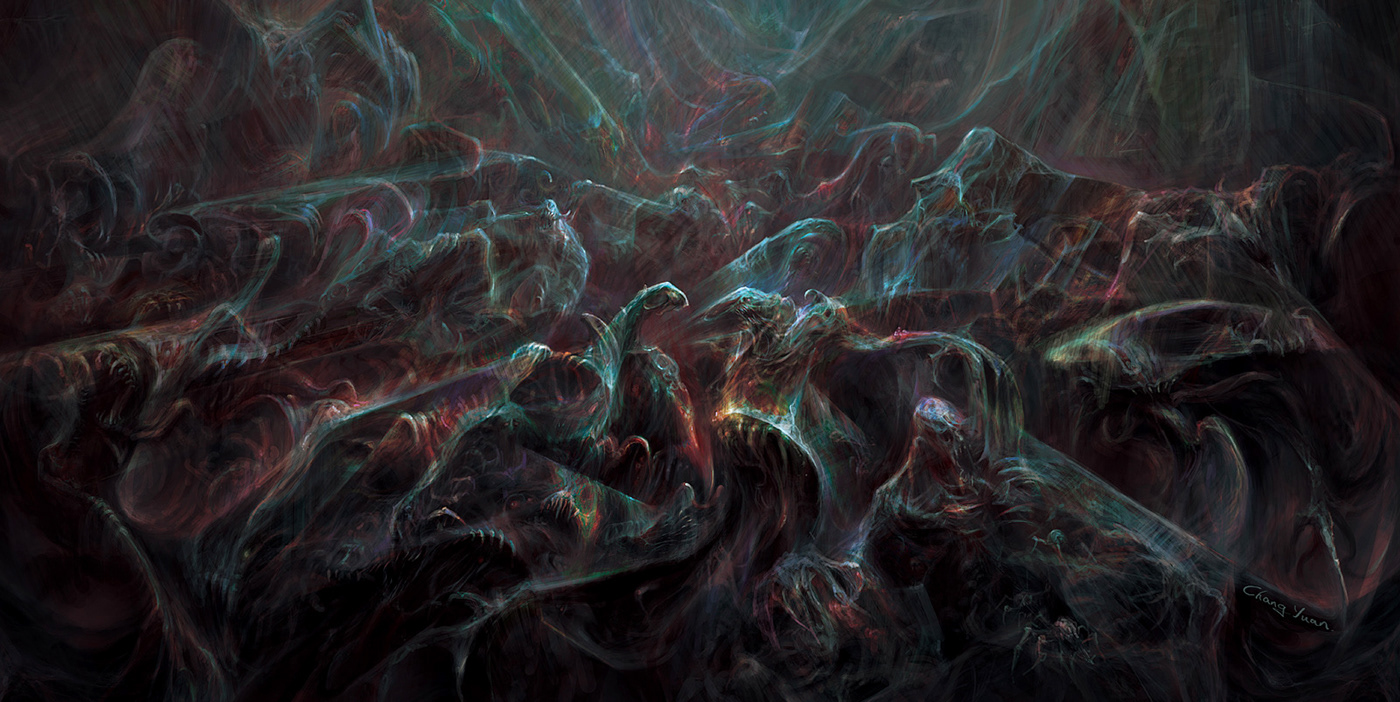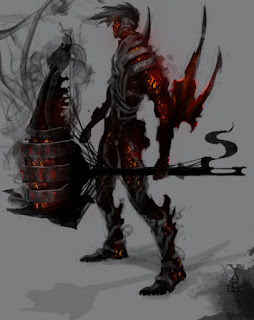“All progressions from a higher to a lower order are marked by ruins and mystery and a residue of nameless rage.”
-Cormac McCarthy, Blood Meridian
This is an archaeology-themed post that explores the idea that your dungeons are built in the literal garbage heaps of history. It is inspired in part by Beneath Foreign Planet’s blog carnival from last year.
Here is how it goes: the DM indicates a potential find in a ruin heap or ancient inscription. An interested player can spend 1d4 hours in-game to attempt a DC 10 skill check. Success yields 1d6 “fragments” relating to that culture that can be spent on translating ancient secrets or rebuilding lost artifacts relating to that culture. In the case of a failed check, reduce the fragments by half. The example culture below yields 1d6 fragments on a successful check, though older cultures should yield fewer (and have more powerful effects).
For DMs: place two archeological sites semi randomly in each dungeon, plus a third one somewhere you don't expect the players to go. The dungeon itself doesn't matter: stones with ancient inscriptions can be found as sewer walls, crappy taverns can have a cool tablet installed as the bar, etc.
An example culture is given below with game mechanics from my bespoke homebrew system; swap them out with suitable incentives for whatever you’ve got going on.
 |
| The Great Dissolution |
The Ctesiphon Civilization
The Ctesiphon Civilization is two thousand years gone. Their decaying monuments are common sights in cities, where it is more convenient to build around them than to destroy them. It must be noted that the stone of that era has a distinctive, black-veins-on-white-marble appearance that is prized as a fashionable building material by moneylenders, among others. No mine for it has yet been discovered. Most of your players have probably heard of the Ctesiphon and know that they built a lot of stuff and then died in a big fire.
Literate characters with an interest in history will know a bit more. The rites of the Ctesiphon lamentation-priests included unique forms of pyromancy accompanied by horrid transformations. Students of history will recall that the Ctesiphon culture ended after their capital city dissolved into a lake of burning slime. Elves call it the "Great Dissolution” and probably remember their grandparents clucking their tongues about it, if nothing else.
Each Ctesiphon discovery results in 1d6 fragments.
Ctesiphon Relics
Carious Curse (2 CC)
You contract an ancient plague whose chief symptom is sores that weep naphtha. This curse is typically contracted through the comprehension of certain Ctesiphon writings, even in part. A character with this condition is vulnerable to fire damage, has +2 mana, receives +1 to CC fragment rolls, and any skill checks made to track you get advantage from you smearing fragrant black oil wherever you go. However, you suffer no social penalty for these sores unless you do not take pains to conceal them. It can be cured by forgetting all knowledge of Ctesiphon language. If you have a boring-ass Remove Curse spell, that cures it for a week.
Ctesiphon Hieroglyphics (4 CC)
You learn a good portion of the triangular Ctesiphon symbol set, though their spoken word remains lost. You get +1 to all future CC finds.
Lacunae Crest (4 CC, 50gp)
Through trial and error you repair a Lacunae Crest, the badge of some kind of religious official. As translated, position is concerned with "ensuring the perforation of the soil” by means of a pretty standard plowing rite. The fragments that discuss the ritual are always decorated in symbols associated with mass conflagrations, though there is no indication how or why those might occur in relation to plowing a field of crops. This badge carries a peculiar charm: it grants resistance against fire damage, but only from area effects, such as fireballs or house fires.
Naphtha Shroud (5 CC, 50gp)
You translate a functional copy of the spell Naphtha Shroud, a 2nd-level spell learnable by arcane or divine spellcasters.
This spell conjures a swirling, oily fog of volatile mist into an area covers a 15'-radius area located within 50 feet. When a creature begins their turn within this area or first contacts it during a round, they must save or suffer 1d8 poison damage. Additionally, creatures within the target area suffer +5 damage from fire damage as a portion of the flammable vapor burns. Finally, creatures that contact the mist halve all range increments for their attacks and spells until the end of their turn as their eyes are smeared with condensed oil. Casting this spell requires the expenditure of 1 Ctesiphon fragment.
At Higher Levels: For each level above 2nd, this spell inflicts +1d6 damage and the diameter increases by 5 feet.
Infection Bore (6 CC, 50gp)
You remake an Infection Bore from salvaged parts. This machine is used to harvest Solar Ichor. It is about the size and complexity of an aeolipile, but can only be operated in an open, flat area in full sun. For each day of operation, it produces 1 vial of Solar Ichor, see below. It also heatlessly converts a one-foot radius around itself to greasy black embers, cumulatively. This effect extends to a depth equal to its radius. Anybody that operates this machine experiences vivid nightmares in which an agonized personification of the sun begs them to destroy the machine. For each day of operation, the machine has a cumulative 5% chance of breaking down and cumulative 1% chance of drawing a posse of Heliacal Paladins.
Solar Ichor looks like gold dust mixed with motor oil. Quaffing it heals 1d8 hitpoints and prevents aging for 1 month. When evaporated into crystals, it functions as gunpowder.
 |
| I'm ready to learn archeology, professor! |
Scroll Of Lesser Dissolution (6 CC, 25gp, 1 solar ichor)
Using a vial of solar ichor as ink, you record a crude version of ancient lamentation. The resulting scroll can be expended by a willing reader, who transforms into a horrid ooze of swirling black goop, covered with eyes and mouths. In this state the reader is effectively helpless as they are subjected to wild visions of the cosmos and astral realms for several hours. The hallucinations grant a certain insight: they forever have +2 to saves and resist damage inflicted by priest spells and sacred beasts such as temple bulls. Translated writing indicates that the Ctesiphon believed this to be a much-sought-after holy state, reserved for their most pious nobility, and that with repeated use it sometimes becomes permanent.
 |
| Something like this. |
Ghost Jewelry (7 CC, 50gp)
It was a common practice in Ctesiphon cities to protect expensive goods by rendering them invisible. The enchantments used were robust enough that an item can sit unnoticed in the corner of a disused ruin, lo these many centuries. By repeatedly effecting the counterspell in disused areas, you eventually discover an ancient piece of grimy, unwholesome jewelry. The piece itself is difficult to visually parse, resembling a half-melted creature something like a goat, perforated and pitted with holes, and all wrought in lurid gold. It is not good to look at. Children cry to behold it and cats hiss at it. The brave soul that wears it as an amulet finds that they resist cold damage and deal +1 damage with attacks and spells.
The Dripping Crown (10 CC, 50gp)
You have laboriously reassembled a functional Dripping Crown, the symbol of high Ctesiphon nobility. The crown as remade is half greasy-looking gold and half ceramic repair materials, but it functions, oh yes it does. To use it, one must wear it for a full day and night, even while sleeping. One knows that it has worked because it begins shining a shallow light and sweating constant droplets of oil.
The wearer is completely immune to spells of 2nd-level or lower, whatever their nature. Once per day as an action, the crown can be made to emit a 30-foot cone of burning oil that inflicts 3d6 damage, save half. Creatures that succeed are covered in a sheen of flammable oil that makes them vulnerable to the next fire damage that they suffer, until cleaned in some way. Rolling in sand is vastly more effective at removing it than jumping in water. Finally, the crown’s light is accurséd, incurring a -1 penalty to random encounter checks.

